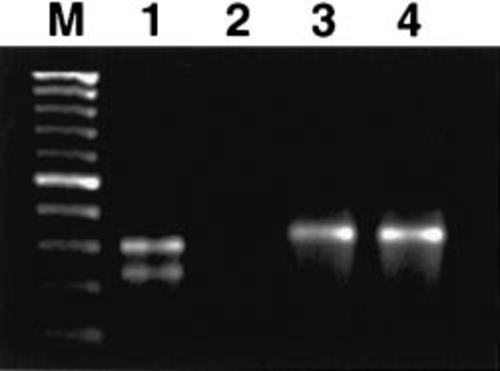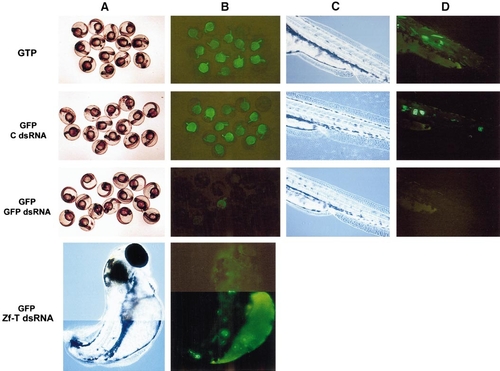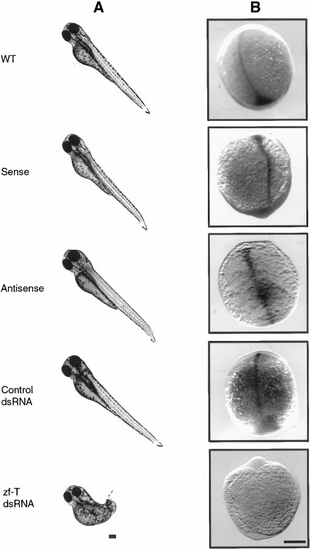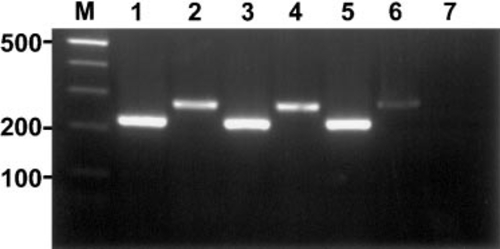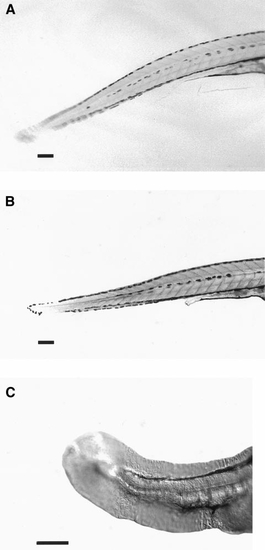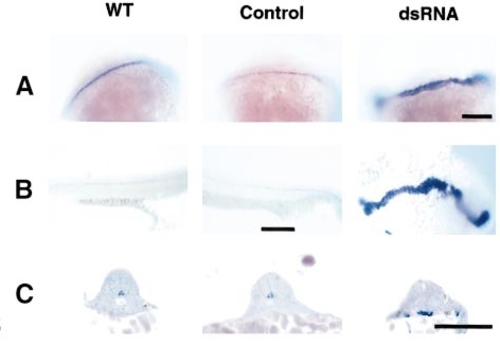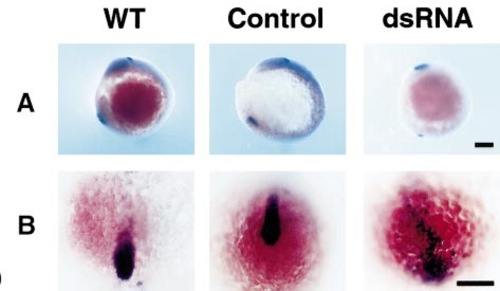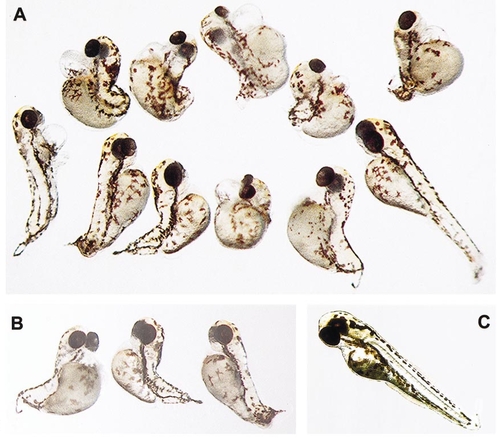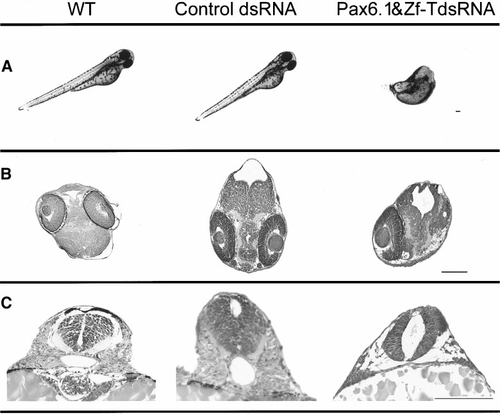- Title
-
Double-stranded RNA injection produces null phenotypes in zebrafish
- Authors
- Li, Y.X., Farrell, M.J., Liu, R., Mohanty, N., and Kirby, M.L.
- Source
- Full text @ Dev. Biol.
|
Demonstration of annealed Zf-T double-stranded RNA. Sense and antisense Zf-T RNA strands (lane 1) were treated with Rnase A before (lane 2) and after annealing (lane 4). Each lane was loaded with 0.5 μg of treated (lanes 2 and 4) or untreated RNA (lanes 1 and 3). |
|
The effect of GFP double-stranded RNA injection on the transient expression of GFP in zebrafish embryos. Single-cell or 16-cell zebrafish embryos were injected with the GFP expression vector, pEGFP-N1. The embryos were coinjected with either GFP double-stranded RNA or a control double-stranded RNA. Columns A and C show the same field of embryos by light microscopy as seen under fluorescence in columns B and D, respectively. Columns A and B show embryos injected at the single-cell stage while columns C and D show embryos injected at the 16-cell stage. Rows 1–3 are designated by treatment to the left as injected with the GFP expression vector alone (row 1), GFP expression vector with control double-stranded RNA (row 2), or GFP expression vector with GFP double-stranded RNA (row 3). The embryo shown in row 4 was injected at the single-cell stage with GFP and Zf-T double-stranded RNA. While the zebrafish yolk does show some autofluorescence at higher magnifications, it is not apparent at the magnification shown in columns A and B. The yolk fluorescence seen here is from the GFP expression vector and is specifically attenuated by double-stranded RNA to GFP. On the other hand double-stranded RNA targeted to Zf-T does not interfere with GFP expression and since this embryo shows the ntl phenotype, the presence of the GFP expression vector does not attenuate the function of the Zf-T double-stranded RNA. |
|
The ntl phenocopy produced by microinjection of double-stranded Zf-T RNA into single-cell embryos. (A) No abnormal phenotypes were apparent subsequent to injection of Zf-T sense or antisense RNA. The injection of double-stranded control RNA also produced no apparent phenotypes. Embryos injected with double-stranded Zf-T RNA exhibited greatly reduced tails and their somites lacked the typical chevron shape of those in the wild-type embryos. The embryos shown are 5 days old (A). (B) In situ hybridizations demonstrate that 9-h embryos lack Zf-T expression following double-stranded Zf-T RNA injection into single-cell embryos, although sense RNA, antisense RNA, and doublestranded control RNA injection had little effect on Zf-T expression. Scale bars = 100 μm. |
|
RT-PCR showing β-actin (lanes 1, 3, 5) and Zf-T (lanes 2, 4, 6) in wild-type (lanes 1 and 2), control double-strand RNA (lanes 3 and 4), and Zf-T double-stranded RNA (lanes 5 and 6) treated embryos. Lane 7 is the negative control for the RT-PCR. The Zf-T RNA expression is reduced by about 75% after Zf-T doublestranded RNA treatment compared to wild-type and control. |
|
Effect of Zf-T double-stranded RNA injection on development of the notochord in 24-h zebrafish embryos. Wild-type zebrafish and embryos injected with the control double-stranded RNA developed an obvious notochord. Ntl mutant embryos lacked a notochord along the entire body axis. Twenty-one percent of the embryos injected with the Zf-T double-stranded RNA also lacked a notochord along the entire body axis. Another 60% lacked notochord in the posterior portion of the body axis. Scale bars = 100 μm. |
|
Effect of Zf-T double-stranded RNA injection on development of the somites in zebrafish embryos. (A) Wild-type zebrafish embryos and (B) those injected with control double-stranded RNA developed characteristic chevron-shaped somites. (C) Zebrafish embryos that had been injected with double-stranded Zf-T RNA developed somites that lacked the typical chevron shape. Scale bars = 100 μm. |
|
Effect of Zf-T double-stranded RNA injection on the expression of sonic hedgehog. RNA in situ hybridizations for shh show a one-cell-wide row of cells in the floorplate that are labeled along the length of the trunk and tail in wild-type embryos and embryos injected with a control double-stranded RNA. In embryos injected with Zf-T double-stranded RNA, the floorplate has expanded and expression of shh is 3–4 cells wide, similar to the expression found in the ntl mutant. Scale bars = 100 μm. |
|
Effect of Zf-T double-stranded RNA injection on the expression of floating head. (A) Side views and (B) dorsal views of tailbud stage zebrafish embryos. RNA in situ hybridizations show that flh is expressed in an axial stripe in the wild-type embryos and in those injected with the control double-stranded RNA. An embryo injected with Zf-T double-stranded RNA shows diffuse flh expression in the tailbud and intense expression in the anterior nervous system, while expression in the body axis was greatly diminished. Scale bars = 100 μm. |
|
(A) The range of phenotypes observed in 72-h zebrafish embryos following injection of Zf-T double-stranded RNA. (B) Three embryos with a complete phenotype. Histological sections were used to confirm that the notochord was absent. (C) One embryo with a partial phenotype which was confirmed by histological section to have an anterior notochord. |
|
Absence of Pax6.1 expression results in severe abnormalities of head development. (A) The 48-h embryos injected with double-stranded control RNA had normal phenotypes. Microinjection of double-stranded Zf-Pax6.1 RNA into single-cell zebrafish embryos resulted in 25% of the embryos having reduced eyes often accompanied by diminished and disorganized forebrains. (B) In situ hybridizations demonstrated that 24-h embryos lack Zf-Pax6.1 expression following double-stranded Zf-Pax6.1 RNA injection into single-cell embryos, although double-stranded control RNA injection had no apparent effect on Zf-pax6.1 expression. Scale bars = 100 μm. |
|
Coinjection of the Zf-T and Zf-Pax6.1 double-stranded RNA generates embryos with defective notochords and eyes. (a) Zebrafish embryos injected with double-stranded Zf-T and Zf-Pax6.1 RNA developed significant defects in the eyes and tail. Zebrafish embryos shown are 5 days old. (b) Cross sections of 48-h embryos show that these defects included diminished eye and brain structures and (c) diminished or lacking notochord along with disorganized somites in the tail. Scale bars = 100 μm. |
Reprinted from Developmental Biology, 217(2), Li, Y.X., Farrell, M.J., Liu, R., Mohanty, N., and Kirby, M.L., Double-stranded RNA injection produces null phenotypes in zebrafish, 394-405, Copyright (2000) with permission from Elsevier. Full text @ Dev. Biol.

